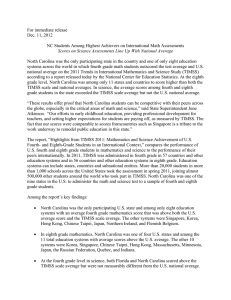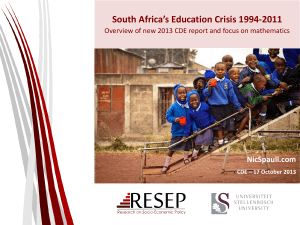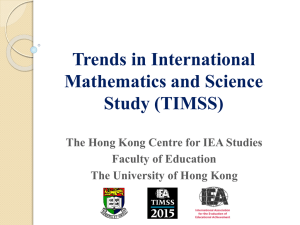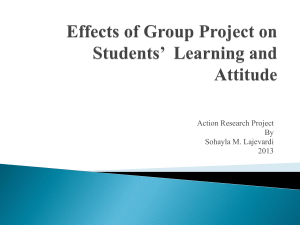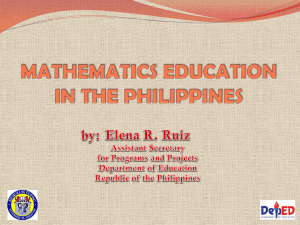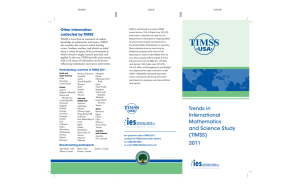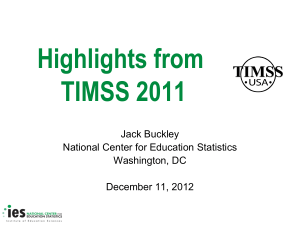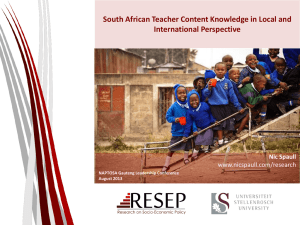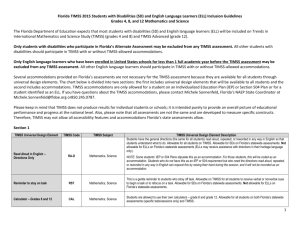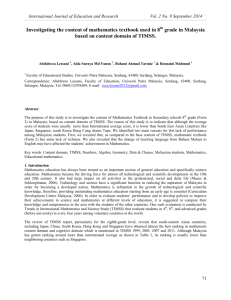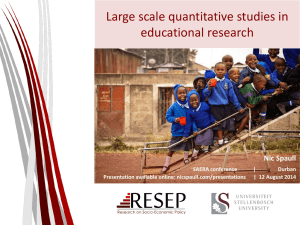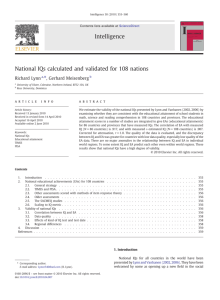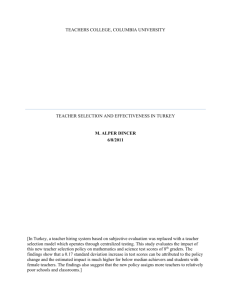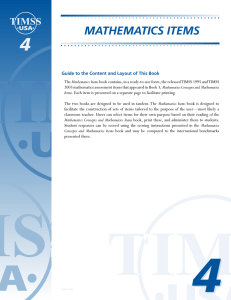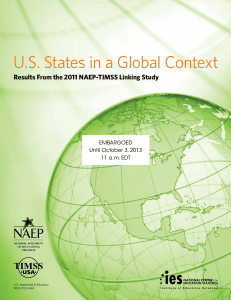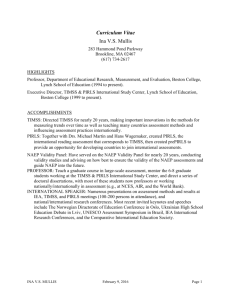The Importance of International Assessments
advertisement
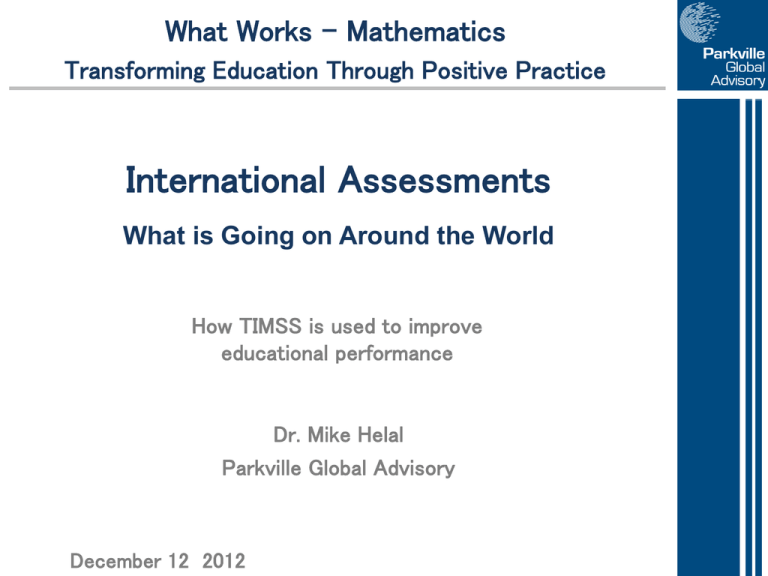
What Works – Mathematics Transforming Education Through Positive Practice International Assessments What is Going on Around the World How TIMSS is used to improve educational performance Dr. Mike Helal Parkville Global Advisory December 12 2012 The Importance of International Assessments International assessments were designed and continue to be managed as research projects, with the aim of answering what we are here to explore today, ‘What works, for whom, in what context and under what circumstances?’ 2 The Importance of International Assessments TIMSS and PIRLS provide us with measurable indicators of how well students can read, how proficient they are in mathematics and how knowledgeable they are in science. This, together with information about which factors are most related to achievement, provide us with empirical insights into how to improve educational outcomes for our students. Decades of research have proven the invaluable potential for enhancing education by using the findings arising from these major studies. 3 How We Interpret the "Curriculum" TIMSS today uses the term curriculum, broadly defined, to consider how educational opportunities are provided to students, and the factors that influence how students use these opportunities. – What are the students expected to learn? – Who delivers the instruction and how is instruction organized? – What have students learned? 4 Intended Curriculum Implemented Curriculum Achieved Curriculum How we can use international assessments Evaluate our implemented curriculum – How is mathematics instruction organised in our school? – How is mathematics assessed in our school? Investigate our achieved curriculum – What do our students know about the different components of mathematics? – What can our students do in mathematics compared to similar students elsewhere and why? 5 TIMSS and the Implemented Curriculum Highlights from a schooling transformation: Slovenia TIMSS Mathematics 6 462 479 502 513 1995 2003 2007 2011 TIMSS Mathematics Content Domains TIMSS items: Time spent on each domain in Dubai: Data Display 19% Geometric Shapes and Measures 24% 7 Data 15% Number 57% Geometry 26% Number 27% Algebra 32% TIMSS and the Implemented Curriculum A Grade 4 TIMSS question: 8 Evaluating our Achieved Curriculum Who do we want to know more about: • Gender • Nationality • Schools offering same curriculum What do we want to know about them: • Content and cognitive proficiency • Distribution of student achievement • Benchmark level descriptors What other outcomes are we interested in: • Students and Parents • Teachers and Schools 9 Who do we want to know more about? 10 Understanding the Gender Differential “Student performance data needs to be unpacked by every different type of student we have.” School principal – Northampton, UK (2009) This Northampton school was determined to understand why the average scores for girls were higher than those of boys at their school. Detailed TIMSS analysis revealed where the gender differential truly was. High achieving boys performed better than girls. At the other end of the scale, the opposite was found. Solutions driven by international assessment data: • Differentiated support • Whole-school numeracy drive • Parental involvement 11 Understanding the Gender Differential Grade 4 Mathematics 650 600 550 500 450 400 350 300 250 200 5th 10th 25th 50th Percentiles of Achievement 12 75th 90th 95th What do we want to know about them? 13 The Building Blocks of Mathematical Knowledge “Data is the starting point for target setting – you need to know what the students are and are not capable of doing at the outset, and you need to set targets in relation to each individual student.” Numeracy champion – Melbourne, Australia (2012) At this Melbourne primary school, teachers were unsure where to start. Their Mathematics score in TIMSS 2007 was amongst the lowest in the state. In collaboration with a neighbouring school, the school hired a numeracy coach to address the issue. In 2011, their students' numeracy skills were found to be in the country's top quartile. Solutions driven by international assessment data: • Building teacher confidence in numeracy • Professional learning communities • Numeracy champion 14 The Building Blocks of Mathematical Knowledge Mathematical Content Domain minus Overall Math Score – Grade 8 60 Students perform relatively better in this domain 40 20 0 -20 -40 -60 -80 Korea Singapore Finland Number 15 United States England Australia Algebra Geometry Dubai, UAE Lebanon Qatar Data and Chance Saudi Arabia Oman What other outcomes are we interested in? 20 Students’ Attitudes to Mathematics - Grade 4 “They were doing okay, but we found out from the student survey that they were not enjoying it. This discovery led to the school running professional learning to build the capacity to teach through instructional games.” -Curriculum coordinator, Ontario (2011) This Ontario school wanted to focus on an attitudinal outcome other than achievement scores. Background questionnaires in TIMSS provided an ideal resource. The survey questions allowed the school to measure and benchmark its students' confidence, engagement and enjoyment of Mathematics. Solutions driving by international assessment data: • Real-world learning • Interdisciplinary focus • Mathematics competitions 21 Students’ Attitudes to Mathematics - Grade 8 Proportion of Students Reporting High Levels of: 60 % 50 40 30 20 10 0 Lesson Engagement Confidence Dubai 22 Enjoyment International average Value Growth Through Positivity The benefits of international assessments are best realised when the analysis, research and data are fully utilised. • • • • Understand how your students learn Identify comparative strengths in your students' knowledge Monitor how your students progress Determine what affects students most Major positive findings from TIMSS • Substantial progress • Grade 4 engagement • High expectations Investigate, evaluate, share and continue to revisit what works. 23 Thank you 24



